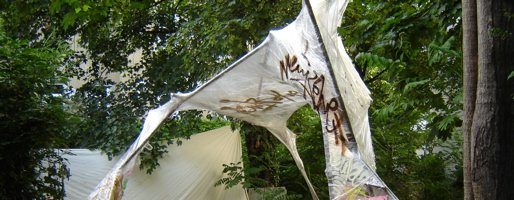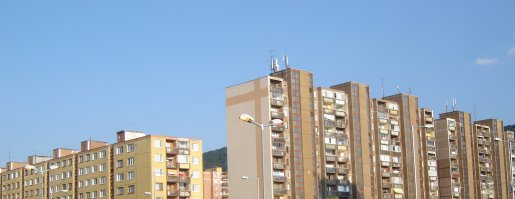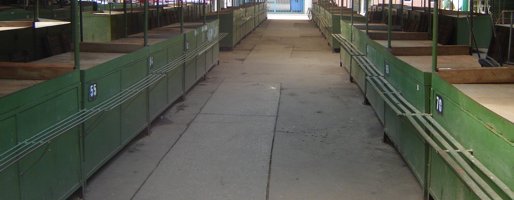stadlnova
Stadlnova is a fictive suburb, located somewhere between Vienna and Bratislava. It provides the conceptual frame for a temporary artistic research platform, where certain features and characteristics of two cities would be confronted. Regardless of aking myths of economic growth and regional developement, we would like to invite people to ask "what if?" to locally available human and spatial potentials. By that, Stadlnova could raise even more questions, but also open new perspectives on collaboration, (sub-)urban space and the everyday in and between Vienna and Bratislava. At a later stage all that will be published in an 'Un-guidebook to Stadlnova'. And now: music!
The first phase of our project was comprised of two interdisciplinary workshops, having taken place right in Devinska Nova Ves (Bratislava) and Stadlau (Vienna) in early summer 2011. Therefore we invited a bunch of people from Vienna and Bratislava, who defined the parameters of Stadlnova, and started collaborating on new ideas and questions emerging from it.
Check our project website www.stadlnova.net for updates and to find out more!
///
'Stadlnova' is a joint project of 'Mobile Initiative Kultur' and urbanflow, supported by

Bratislavsky Souk
In the Arab world a souk is a market or bazar, which is usually a vital part of everyday city life. In Bratislava's boom-bubble, 'Souk a.s.' is the name of a company, which is just about to make the last vital open air marketplace in vicinity to its city center disappear.
In many cities of the Middle East, souks are still constituting the major commercial and social lifelines, and in much of the so called 'West', one can currently witness a revival of 'farmers markets' and the likes. However, official Bratislava doesn't show much appreciation for the market (trhovisko) at Žilinská Street. Over the course of the last years there has been many discussions about closing down the market , but now this fate seems inevitable. It has been announced that the plot will soon be cleared for the erection of yet another 'polyfunctional complex', contributing to Bratislava's vitality with the functions of parking, commerce - including a supermarket as compensation for the market - and yet more capsules for glossy consumerist role models.
So you'd better hurry up to dive into the unique milieu of southern Slovak veggie growers, reminding you that peppers can well have a rich-crunchy taste, and strenuous grannies selling their homemade elderberry juices. The market is just a haven for those Bratislavians, who have not yet been pocketed by the ubiquitous hypermarket culture, the ones who prefer to act local by grabbing a bit of delicious non-pasteurized Bryndza cheese, or by indulging in the infamous tramp evenings in 'Drevena Dedina' (wooden village - sic!), a dream of a pub-cottage adjoining the market .
We started a little sound mapping project about the site of Žilinská market, collecting atmospheres, oral (hi)stories and memories, perhaps.
Check it out on http://aporee.org/maps/projects/zilinska
Update 06-11-2011: The 'queen of root vegetable' from Zahorie region had good news: The vendors at the market got the rental agreements for their stalls prolonged for another year. The phantom named economic crisis seems to be on our side.
Update 10-12-2012: According to latest information, the vendors and visitors of Zilinska will be able to frequent the market yet for at least another year.
Update 25-08-2013: Even though four stalls have recently been removed to make space for parking, the harvesting season is in full bloom. Well, it seems as if there wasn't any cause for concerns about the market's existence.
Update 16-05-2014: The first peas are on the market - any doubts?
Update 15-03-2015: Yes, it's still around, and after some uncertainties at the beginning of the year, yet again the market vendors got their contracts renewed till December.
Bratislava
From 08-2010, work in progress
Searching for Karolina (!!!)

The vision is something like a 'New Ostrava', manifesting itself in built exclamation marks, all promoted by a large scale intrusive city branding campaign. Developers' slogans sounding like: "Erected on the city's prime brownfield site, New Karolina will be the new city centre, a reminder of what we can continue to build on for the future."
But Honza and Ludo, living for years in makeshift tents at the margins of what is and supposed to be, don't seem to care about the excavators, already performing an awkward dance just across the fence. A sign that the vision is already beginning to be imposed, exclamation marks challenging what used to be known just as 'Karolina'. Time was tight, so I went along the fence to search for her. Maybe Karolina wouldn't even want more than just to be...
///
The project 'Searching for Karolina (!!!)' is featured on 'radio aporee' and was conducted as part of a research project on urban voids together with Federica Gatta and Giorgos Doganis, under the title 'Ostrava: Narrating the city through its absence'.
Ostrava, Czech Republic
23-04 till 27-04-2010

Encountering СИХІВ

While the historic center of L'viv is increasingly being promoted as some 'New Prague' (or 'you name it') by the hype machines of tourism industry, there is also its 'urbanistic other', a failed Soviet utopia as well as a reservoir for the neoliberal L'viv to become: Syhiv (СИХІВ)
During a month-long stay in L'viv during August 2009 (thanks to a mobility grant awarded by the 'Gulliver Connect Programme'), I was actually living right in Syhiv, which raised my interest in that area. Soon after my return back to Bratislava, I stumbled upon an earlier version of syhiv.com, run by Elena and Yuriy, who were actually growing up in Syhiv. They have started this project to contextualize their experiences and observations, creating some kind of record about their suburban socio-spatial consciousness. Their virtual node syhiv.com is a profound and steadily growing array of texts and images, fragments of the actual (sub-)urban realities and what was and could have been. In an introduction to their project, Elena and Yuriy wrote:
CNXIB is about the lost memory written in the remanents of a once created future. it’s not about decay, but about possible forms of life after the key-narrative is gone. it’s about how the narrative of lifes is always outside of the realm of concepts/ideologies. there is always someone around. even in the fields, even in the woods, even in the backstreets.
In late March 2010 I finally got the chance to visit Syhiv again and meet Elena and Yuriy. They took me for walks through the blurred spheres of their neighbourhoods. During those days I could also win Elena for some site-specific recording-sessions, where she reflected about her relation to certain places as well as some peculiar characteristics of Syhiv. Have a listen to them on radio aporee.
Syhiv/L'viv, Ukraine
19-03 till 23-03-2010
Big up to Elena and Yuriy, syhiv.com!
(By the way, Elena does some fabulous illustration work, make sure to check it out on hippodromewithouthorses.com)

Chops Minimal Echo

once a major railway hub, entrance gate to the 'socialist sixth of the world'
today chop's train station seems somehow stranded, off the current
echoing sounds that could make you think it's breathing its last breath
still, you can choose
bare sole wagons across the new iron curtain to cierna nad tisou, zahony
or a sublime sleeper train to moscow
Chop, Ukraine
18-03-2010

minskflaneur

Central Minsk can become a nightmare for anybody who prefers to encounter a city like a flaneur. It is the stalinist urban utopia come true, with not even a trace of the labyrinth, that Walter Benjamins flaneur was feeding off:
The city is the realization of that ancient dream of humanity, the labyrinth.
It is this reality to which the flâneur, without knowing it, devotes himself.
(Walter Benjamin, The Arcades Project)
Apparently the only place in Minsk, where a flaneur can heave a sigh of relief, is its underground lifelines. The despair of a flaneur in 'hush city' is reflected by the fragments of text and sound that emerged from some extensive strolling around October Square in Minsk in August 2009, which can be found on radio aporee. Here's the text:
Hush City
Not long ago I wanted to find out how you sound. Having soaked up a remarkable dose of sonic density, carried by the infectious rhythm of your underground lifelines, I felt tempted to encounter what's above.
I turned into a flaneur, strolling around, observing.
Universe
Caviar for the common people, on bread and butter, in the vitrines of the peoples drinking palace. Upstairs in the supermarket, teenage style and pop-cultural aficionados were preparing for a clubbing in a parallel universe.
The screen
He needs to be seen, in every public news broadcast. Again it's all about world class potatoes and the best sunflower oil. Don't you love me?
I was the only one watching.
Horizont
I couldn't make sense of this place by walking across its vast plot of concrete, shadowed by a massive monolith, rising out of nothing. Within a glimpse I could read "Horizont" on a rooftop.
I felt so lost.
Live Forever
I turned around, walked to the other side and took a rest on a bench. Young folks all around, sitting, chatting, but their voices seemed to be absorbed by this place. Soon a man came over, flashily dressed, nervously thumbing through a book in front of me -You know?
Perechod
Back in the passage of the metro station I felt less scattered. There it wasn't me, passing by.
I could afford to pause, in the middle of the rush, not being part of it. I chose to lose myself in your lifelines again, where humming engines are drowning out the all-dominant sound of high heels.
///
Minskflaneur has been realised by Jürgen Rendl as part of the international project 'Belarus Inside-Out', organized and published by Plotki. You can download the publication under http://bio.generation.by.
Minsk, Belarus
14-08 till 23-08-2009

Allah Bul Kheer

'Allah bul kheer' is a greeting popular among Iraqi people, wishing peace and wealth. Nowadays it can also be heard frequently in certain Damascene neighborhoods like Jaramanah.
Throughout history Damascus has been a stopover on trading roads. Since 2003 the city has become a temporary haven for many displaced people (refugees) coming from Iraq. Most of them do not have an opportunity to make a living in Damascus. Neither it is safe enough for them to return back to Iraq in the near future. Hence these people hope to get accepted by countries like the USA, Canada, Sweden or Australia.
'Allah bul kheer' is a sound mapping project, attempting to juxtapose the two elements dominating the soundscape in the streets of the Damascene suburb Jaramanah: Displaced people from Iraq, who in most cases are doomed to wait, be it along the streets or inside their makeshift cafes, and the omnipresent Syrian street vendors, constantly roaming around in the narrow lanes.
Allah Bul Kheer has been realised by Jürgen Rendl as part of the international art research project Reloading Images Damascus.
You can find the sound map on radio aporee.
Damascus, Syria
10-2008 till 11-2008

Hafez al-Assad



Damascus-Tabbaleh, Syria
09-11-2008

novy zivot v ottakringu

'Novy zivot' is Slovak for 'new life' and also the name of a village about 20km east of Bratislava. While many Slovaks since the Velvet Revolution of 1989 began a new life, in villages like Novy Zivot, the capital Bratislava or abroad like in the United Kingdom, where many young Slovaks went to find work in the last years, still little is known about the country and its inhabitants. Even just 60km west of Bratislava, in the Austrian capital Vienna, where nowadays many Slovaks work or study, they still hardly leave any traces.
This led us to the idea for the project 'Novy Zivot v Ottakringu', which included the creation of a temporary space of confrontation and encounter with 'the other' from just across the border, implanted right in the center of the Viennese public art festival Soho in Ottakring 2008. Granted support from the festival, we invited two young Slovak artists as kind of 'Gastarbeiter' to design and create a space that would symbolize the new life of many Slovaks and become that place for encounter and confrontation we desired.
What they created was a seemingly light sculptural, semi-transparent structure, which should stand for the new life, surrounded by stylized, street-art like paintings on plaster panels, symbolizing the grey suburban housing estates characteristic for most post-communist cities. During the two weeks of the festival our space became a popular meeting and communication place as well as the point of departure for performances of other Slovak artists we invited. By that at least for some time Novy Zivot could stimulate and exchange between here and there.
///
Novy Zivot v Ottakringu was part of and enabled by the festival Soho in Ottakring 2008.

Vienna
17-05 till 30-05-2008
Idea and concept
Christoph Höschele and Jürgen Rendl
Project team
Jonny Stofko, Marian Kralik, Kathrin Wenzl, Magdalena Schrefel, Wolfgang Eicher, Christoph Höschele, Jürgen Rendl
Photo credits
Wolfgang Eicher, Jürgen Rendl

Placetellers

Motivated by the fruitful experience with our 'nomadic picnic', we developed a collective sound mapping project with the aim to collect and share stories and places, which were appropriated by people and their practices, experiences and emotions. Placetellers was meant to elaborate on the very relationships people are maintaining to certain places in a city, which is currently undergoing rapid and massive changes, that are mostly lacking a democratic base.
As a first step we asked visitors of the network culture festival 'Multiplace 2008' in Bratislava about their appropriated places and stories, which we then used as the base for the itinerary of our 'Placetellers Walk' on the last day of the festival. During this walk we invited people to share their stories about certain places, which we recorded and uploaded to a website. We ended our 'Placetellers Walk' with a picinic and discussion at Bratislavas danube bank, close to the former site of an alternative theater and concert venue, where now a vast luxury city development project is arising...
Placetellers was realized as part of the network culture Festival Multiplace 2008.
We have added some places and stories to a sound map on radio aporee.

Bratislava
28-04 till 03-05-2008
Project team
Barbara Borikova, Jana Surkalova, Jozef Charfaoui, Jürgen Rendl
Photo credits
Agata Marcez, Jana Surkalova

Nomadic Picnic

A collective walk through Bratislava via places which are slightly off the beaten track, but bearing many features characteristic for contemporary Bratislava. The idea was to give people an opportunity to reflect about the changes their city is undergoing in an informal setting - walking, sharing food and thoughts.
To collect people's individual experiences during our walk, we asked the participants to draw maps mirroring their own perceptions and emotions along the way. Additionally we put stickers in the streets we were about to walk, which contained questions and statements about the city likely to to stimulate thoughts. Concluding our 'nomadic picnic' by squatting an abandoned swimming pool for the rest of this balmy summer evening, for many participants enabled a sense for the 'right to the city' within a currently investor dominated cityscape.

Bratislava
19-06-2007
Project team
Barbara Borikova, Jana Surkalova, Jozef Charfaoui, Jürgen Rendl
Photo credits
Jozef Charfaoui, Jürgen Rendl










